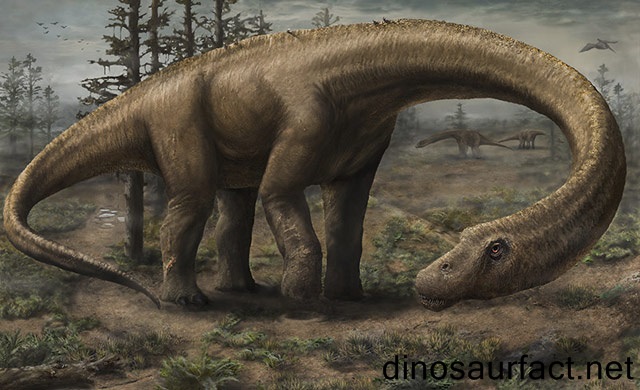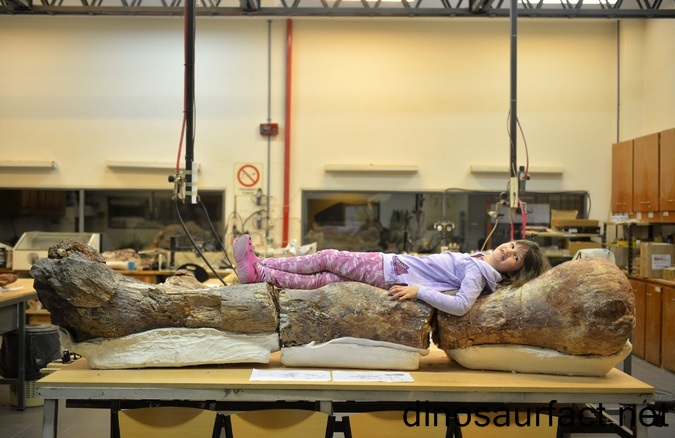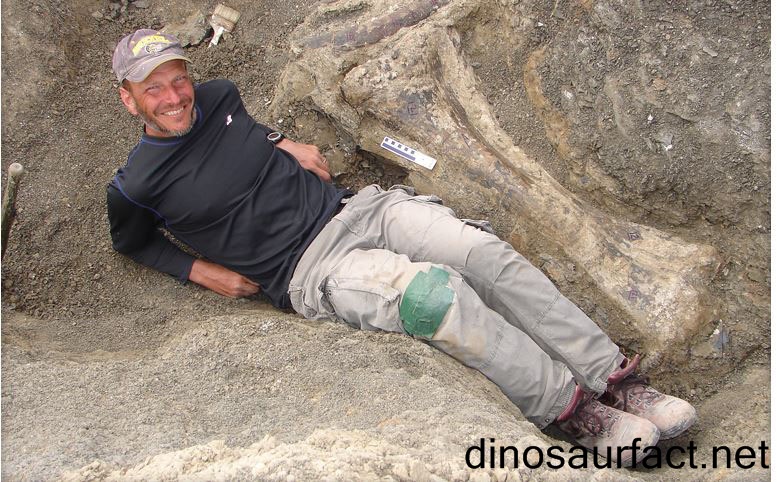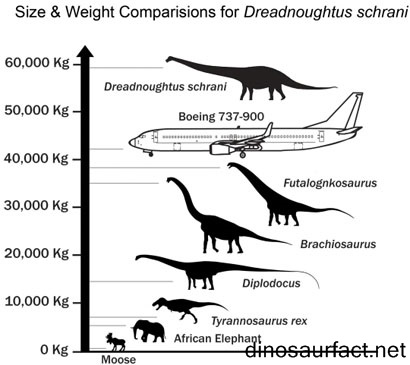 Click to visit the previous dinosaur bio
Click to visit the previous dinosaur bio
 |
|
 |
|
Kingdom: Animalia
Phylum: Chordata
SuperOrder: Dinosauria
Order: Sauropodomorpha
Family: Titanosauria
Genus: Achelousaurus
 |
|
 |
|
 |
|

The Dreadnoughtus was one of the largest dinosaurs to be discovered. This dinosaur lived somewhere between 84 million and 55 million years ago during upper cretaceous period in the Campanian and Masstrichian geoclinal timeline.
Dreadnoughtus weight
The estimated weight of the Dreadnoughtus is 65 tons which is equivalent to twenty H2 Hummers or seven Tyrannosaurus species. It is nearly double the size of a Brachiosaurus. The mass of dinosaurs such as this Titanosaur are accurately measured by the femur and the humerus. Other extinct Sauropod in the Titanosaur family are also very large such as the Argentinosaurus, Gianotosaurus, and Supersaurus.
About Dreadnoughtus Fossils
Dreadnoughtus is known from one holotype specimen and one paratype specimen. The most recent discovery was an impressive 142 bones equaled at a 70.4% complete skeleton. The previous discovery was a partially articulated postcranial skeleton. Both specimens were discovered in the Cerro Fortaleza Formation of Santa Cruz province, Argentina.
- MPM-PV 1156: This was a partial skeleton of the dreadnoughtus fossil to be discovered. The layout of only somewhat preserved. It consisted of a fragment of a maxilla, a tooth, a posterior cervical vertebra, cervical ribs, multiple dorsal vertebrae and dorsal ribs, the sacrum. For the tail skeleton, thirty two caudal vertebrae and eighteen haemal arches that include a sequence of seventeen anterior, middle caudal vertebrae, and their corresponding haemal arches were discovered in their original layout. Also the left pectoral girdle, forelimb, minus the front foot, both sternal plates, the full pelvic elements, the left hind limb lacking a hind foot and right tibia, metatarsals I and II, and one claw from digit I. MPM-PV 1156 is a holotype specimen.
- MPM-PV 3546: This discovery was a younger and smaller dreadnoughtus. It consisted of a partial anterior cervical vertebra, multiple dorsal vertebrae and ribs, the sacrum, seven caudal vertebrae and five haemal arches, a nearly complete pelvis, and a left femur. MPM-PV 3546 is a paratype specimen.
The excavation effort and discovery of MPM-PV 1156 was led by Kenneth Lacovara who is an associate professor of the Drexel University Arts & Science in Philadelphia. The exploration started in February 2005. On the first day Kenneth and his team found a six foot tall femur. By the end of the same day they uncovered 10 separate fossil bones including the tibia, and fibula. The excavation took 4 years and 145 bones was discovered. It was later determined that 115 bones were of a Dreadnoughtus and the remainder 30 were of Juvenile specimen. Lamanna’s claimed “(The Discovery is) a treasure trove of information on one of the most successful, but least understood, dinosaur groups of all. In conclusion to Lamannas’ discovery, the larger specie is believed to not be fully grown due to the quality of the specimens found. The shoulder bones are not fused together as they would be in a mature adult as well as bone growing cells of a youthful individual present. Fine features such as locations of muscle attachment can be seen on the fossils. The 16tons of fossils were delivered to Pennsylvania for studies, on an ocean trader provided by the Argentinian government.
About the Cerro Fortaleza Formation
The Fortaleza Formation is located in the Rio La Leona Valley in Santa Cruz Province, Argentina. It is often referred as the Pari Aike, Chorrillo, or Mata Amarilla Formation. The Cerro Fortaleza Formation is clearly terrestrial and consists predominantly of cross-bedded, friable sandstones inner bedded with layers of mudstones and occasional lignitic horizons.
Cerro Fortaleza Formation has brought many discoveries such as extinct shark teeth, dipnoan teeth, testudine shell fragments, semionotiform/lepisoteid scales, and Chondrichthyan teeth, Agathoxylon, Planoxylon, Taxodioxylon, Cupressinoxylon, and Podocarpoxylon.
About The Dreadnoughtus
A lot of information about Dreadnoughtus can be said due to the most recent discovery being a 45% complete skeleton. This herbivore is 85ft long and 30ft tall. 20ft tall to the dinosaurs shoulder, 37ft long neck, and a 30ft long tail. The Sauropod weighed 59.3 metric tons or 130,734 pounds. The name Dreadnoughtus means “fearer of nothing”. It comes from powerful battleships called dreadnoughts due to them being constructed to be invulnerable to attack. Dreadnoughtus probably spent its days munching massive quantities of plants to fuel its enormous body.
Just for fun we have a soundclip available for you to hear what a Dreadnoughtus could've sounded like. Click to the Dinosaur Sounds area to hear it. Please note that the dinosaur sounds are only for entertainment and are not an actual fact.
Index
Extinct Profiles
 Triassic Dinosaurs
Triassic Dinosaurs Jurassic Dinosaurs
Jurassic Dinosaurs Cretaceous Dinosaurs
Cretaceous Dinosaurs Pterosaurs
Pterosaurs Marine Reptiles
Marine Reptiles Dinosaur Extinction
Dinosaur Extinction